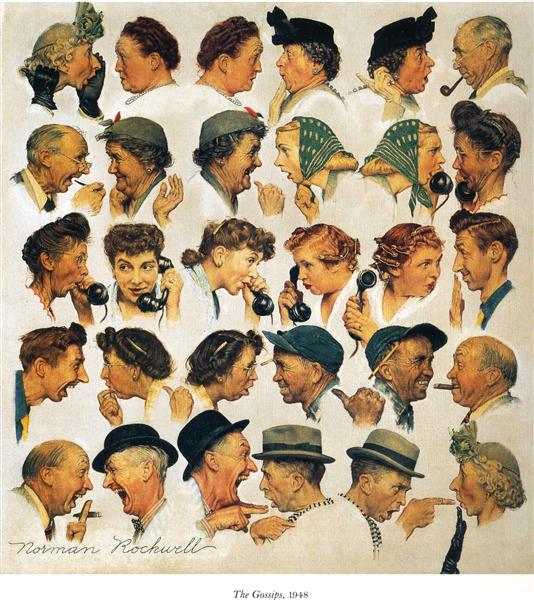Verified: 7 months ago
SafeTensor
The FLUX.1 [dev] Model is licensed by Black Forest Labs. Inc. under the FLUX.1 [dev] Non-Commercial License. Copyright Black Forest Labs. Inc.
IN NO EVENT SHALL BLACK FOREST LABS, INC. BE LIABLE FOR ANY CLAIM, DAMAGES OR OTHER LIABILITY, WHETHER IN AN ACTION OF CONTRACT, TORT OR OTHERWISE, ARISING FROM, OUT OF OR IN CONNECTION WITH USE OF THIS MODEL.
Trained on 41 paintings by the American Illustrator Norman Percevel Rockwell (February 3, 1894 – November 8, 1978). To see his works, please go to
Norman Rockwell is undoubtedly the most influential of all American Illustrators, eclipsing his predecessors J.C. Leyendecker (who was his mentor and whose influence on Rockwell can be seen in his earlier illustration before he developed his own style) and Charles Dana Gibson. It is not hard to see why, because he was able to capture, with verve and humor, an idealized version of post-war America that is forever cemented in the public imagination.
From ChatGPT:
 Rockwell in c. 1921
Rockwell in c. 1921
Norman Percevel Rockwell (February 3, 1894 – November 8, 1978): Master of American Illustration
Biography & Background
Born: February 3, 1894, New York City, U.S.
Died: November 8, 1978, Stockbridge, Massachusetts, U.S.
Artistic Style: Realism, Illustration, Narrative Art
Famous For: Capturing American life through detailed, heartwarming, and often humorous scenes
Norman Rockwell was a prolific American artist and illustrator best known for his idealized yet relatable portrayals of everyday life. His illustrations appeared on over 300 covers of The Saturday Evening Post, and his work became a visual chronicle of 20th-century America.
Artistic Style & Techniques
Rockwell’s work combined technical mastery with storytelling brilliance. Key elements of his style include:
✅ Hyper-realistic detail — His precise brushwork brought characters and settings to life.
✅ Emotional storytelling — Each painting told a clear and compelling narrative.
✅ Warmth and humor — Rockwell’s work often blended sentimentality with lighthearted charm.
✅ Use of models — Rockwell meticulously staged scenes with live models to ensure authenticity.
Notable Works and Their Impact
1. The Four Freedoms (1943)
Inspired by Franklin D. Roosevelt’s 1941 speech, Rockwell painted a powerful series illustrating:
These images toured the U.S. to promote war bonds and became iconic symbols of American values.
2. The Problem We All Live With (1964)
One of Rockwell’s most powerful and socially conscious works.
Depicts Ruby Bridges, a young Black girl escorted by U.S. marshals as she integrates a previously segregated school.
The stark contrast between Ruby’s innocence and the violence implied by the graffiti on the wall marked a bold political shift in Rockwell’s career.
3. Rosie the Riveter (1943)
A strong, muscular depiction of a female factory worker, symbolizing women’s contribution to the WWII homefront.
Rosie became a feminist icon, representing strength and resilience.
4. The Gossips (1948)
A delightful illustration showing a chain of gossip spreading through a small town.
Each character’s exaggerated facial expression captures Rockwell’s talent for visual storytelling.

Cultural Impact
Rockwell’s illustrations became synonymous with American ideals, showcasing family life, small-town values, and moments of quiet heroism.
While often criticized for being overly sentimental, his later work tackled social issues like racism, poverty, and human rights, adding greater complexity to his legacy.
Rockwell’s ability to connect with viewers emotionally has made his work deeply ingrained in American culture.
Influence on Modern Art and Media
Rockwell’s meticulous staging and storytelling influenced cinema, particularly directors like Steven Spielberg and George Lucas.
His use of expressive faces and body language has shaped visual comedy, influencing everything from comic strips to animation.
Many contemporary artists have reinterpreted Rockwell’s themes, blending nostalgia with modern social commentary.
Legacy
The Norman Rockwell Museum in Stockbridge, Massachusetts, preserves his extensive body of work.
Today, Rockwell’s art is appreciated not only for its technical brilliance, but also for its ability to capture the evolving identity of American society.
Would you like to explore specific themes in Rockwell’s work, his influence on pop culture, or details about his artistic techniques?
Norman Rockwell’s Influence on Pop Culture
Norman Rockwell’s visual language has had a profound and lasting impact on American pop culture, shaping everything from film and television to advertising and music. His ability to blend nostalgia, humor, and storytelling has made his work a touchstone for visual narratives that celebrate — and sometimes critique — American identity.
1. Influence on Film and Television
Many filmmakers have drawn direct inspiration from Rockwell’s compositions, storytelling techniques, and visual tone.
Directors Inspired by Rockwell
🎬 Steven Spielberg — Known for his family-centered narratives and emotional warmth, Spielberg often mirrors Rockwell’s idealized yet emotionally rich scenes.
The Color Purple (1985) features tender family moments framed in a Rockwellian style.
Saving Private Ryan (1998) captures Rockwell’s reverence for everyday heroism.
🎬 George Lucas — An avid collector of Rockwell's work, Lucas credits Rockwell's ability to tell a complete story in a single image as a major influence on his storytelling.
🎬 David Lynch — While Lynch’s unsettling films contrast with Rockwell’s warm aesthetic, Lynch often juxtaposes “idyllic Americana” (inspired by Rockwell) with eerie undertones.
TV Shows Inspired by Rockwell
📺 The Wonder Years (1988–1993) — The series' nostalgic tone and small-town family life reflect Rockwell’s influence.
📺 Mad Men (2007–2015) — The show’s visual style frequently mimics Rockwell’s meticulous compositions.
2. Influence on Advertising and Marketing
Rockwell’s art became a visual shorthand for comfort, trust, and tradition, which advertisers eagerly adapted.
✅ Brands like Coca-Cola, McDonald’s, and Ford have referenced Rockwell’s wholesome aesthetic in campaigns promoting family values.
✅ His themes of childhood innocence, family gatherings, and hard work have been repurposed in countless advertisements promoting products ranging from insurance to clothing.
3. Influence on Fashion and Design
Rockwell’s imagery, often showcasing Americana fashion staples (like plaid shirts, denim, and simple attire), has been emulated in:
👕 Ralph Lauren and other designers have used Rockwell-esque themes to evoke timeless, family-centered lifestyles.
🎨 Graphic design and editorial layouts frequently borrow his crisp visual storytelling style.
4. Influence on Music and Album Art
Rockwell’s storytelling qualities and iconic Americana themes have inspired musicians as well.
🎵 Billy Joel’s Turnstiles album cover (1976)* features a group of diverse New Yorkers posed in a Rockwell-like tableau.
🎵 John Mellencamp and Bruce Springsteen have written songs echoing Rockwell’s narratives of working-class America.
🎵 Rockwell (the musician) adopted the artist’s name as a stage persona, reflecting nostalgic themes.
5. Influence on Contemporary Artists and Pop Art
Andy Warhol — While Warhol’s bold pop art style contrasts with Rockwell’s realism, Warhol admired Rockwell’s ability to create relatable, iconic imagery.
Banksy — The street artist has parodied Rockwell’s famous works, using his idyllic style to highlight modern social issues.
Mark Ryden — Known for his “pop surrealism,” Ryden frequently draws on Rockwell’s narrative clarity with a darker twist.
6. Influence on Comic Books and Illustration
Rockwell’s exaggerated facial expressions and detailed staging influenced comic artists like Will Eisner and Alex Ross, both known for blending realism with visual storytelling.
Alex Ross’s iconic superhero portraits — particularly for DC Comics — echo Rockwell’s focus on emotional depth and character-driven storytelling.
7. Influence on Photography and Visual Media
Photographers like Annie Leibovitz and Gregory Crewdson have drawn from Rockwell’s talent for capturing character emotions and staged moments.
📸 Leibovitz’s celebrity portraits often mimic Rockwell’s staged, narrative-driven compositions.
📸 Crewdson’s cinematic photography, though more surreal, mirrors Rockwell’s use of detailed environments and visual storytelling.
8. Cultural References and Parodies
Rockwell’s iconic scenes are frequently referenced — or satirized — in popular culture.
🖼️ The Simpsons has recreated several Rockwell paintings in parody episodes.
🖼️ Family Guy has mimicked Rockwell’s wholesome aesthetic for comedic effect.
🖼️ Saturday Night Live has staged live-action re-creations of Rockwell’s famous scenes.
Conclusion
Norman Rockwell’s influence on pop culture is extensive and enduring. His signature blend of warmth, narrative, and emotional clarity continues to shape visual storytelling across multiple mediums. Whether through the sentimental family scenes in advertisements or the cinematic language of iconic filmmakers, Rockwell’s impact remains deeply woven into modern culture.
Would you like an analysis of specific paintings that have shaped pop culture, or explore how contemporary artists reinterpret his style?









